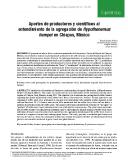| dc.contributor.author | Jarquín Gálvez, R. | |
| dc.contributor.author | Jiménez Sánchez, L. | |
| dc.contributor.author | Guharay, F. | |
| dc.contributor.author | Barrera, J.F. | |
| dc.date.accessioned | 2015-03-19T20:56:24Z | |
| dc.date.available | 2015-03-19T20:56:24Z | |
| dc.date.issued | 2005 | |
| dc.identifier | 470202 | es_ES |
| dc.identifier.issn | 1659-0082 | es_ES |
| dc.identifier.uri | https://repositorio.catie.ac.cr/handle/11554/5783 | |
| dc.description | 2 ilus. 28 referencias bibliográficas. También publicado en: Boletín PROMECAFE (IICA). (no. 106) p. 7-12 Ene-Mar 2006. | es_ES |
| dc.description.abstract | El presente estudio se llevó a cabo en comunidades del Soconusco y Sierra del Estado de Chiapas, México, con el objetivo conocer la percepción de productores de café en torno a la distribución espacial de la broca del café, Hypothenemus hampei (Ferrari). Se aplicaron encuestas y se realizaron recorridos de campo y muestreos, contrastando el conocimiento local con el científico reportado en la literatura. De 171 productores interrogados, 63 porciento mencionaron que la distribución de la broca dentro del cafetal no era uniforme. La mayoría de los productores identificaron la existencia de "focos" o "manchones" de infestación de broca y los atribuyeron a varias causas. La observación y la recolección de frutos fueron las formas más utilizadas por los productores para identificar los focos de infestación. La presencia de sitios de agregación de la broca en los cafetales está aparentemente vinculada a un complejo de factores naturales y no naturales, coincidiendo en este punto productores e investigadores. Este estudio proporciona una aproximación metodológica que puede servir de base a estudios posteriores que traten de seguir eslabonando el conocimiento local con el externo. This study was carried out in rural communities of the Soconusco and the Sierra regions of Chiapas State, Mexico, during 2001. The objective was to examine the perception of coffee farmers regarding the spatial distribution of the coffee berry borer (Hypothenemus hampei). Farmer interviews and sampling of coffee plots were performed to compare local knowledge with scientific studies reported in the relevant literature. Of 171 farmers interviewed, 63 percent mentioned that the coffee berry borer did not follow a uniform distribution within the coffee plots. The majority of farmers identified the existence of "hot spots" or "patches" of coffee berry borer infestation that were attributed to various causes. The observation and collection of coffee berries were the preferred methods used by the farmers to identify patches of coffee berry borer infestation. Farmers and researchers both agreed that the aggregated distribution of the coffee berry borer is related to a complex of natural and anthropogenic factors. This study provides a methodological framework that can be used as a basis for subsequent studies that attempt to improve the flow of information between growers and scientists interested in pests, weeds and plant diseases. | es_ES |
| dc.language.iso | es | es_ES |
| dc.publisher | CATIE, Turrialba (Costa Rica) | es_ES |
| dc.subject | COFFEA ARABICA | es_ES |
| dc.subject | HYPOTHENEMUS HAMPEI | |
| dc.subject | INSECTOS DAÑINOS | |
| dc.subject | PLAGAS DE PLANTAS | |
| dc.subject | INFESTACION | |
| dc.subject | CONTROL DE PLAGAS | |
| dc.subject | CONOCIMIENTO INDIGENA | |
| dc.subject | CHIAPAS MEXICO | |
| dc.title | Aportes de productores y científicos al entendimiento de la agregación de Hypothenemus hampei en Chiapas, México | es_ES |
| dc.title.alternative | Contribution of scientists and farmers to understanding the spatial distribution of Hypothenemus hampei in Chiapas, Mexico | es_ES |
| dc.type | Artículo | es_ES |


